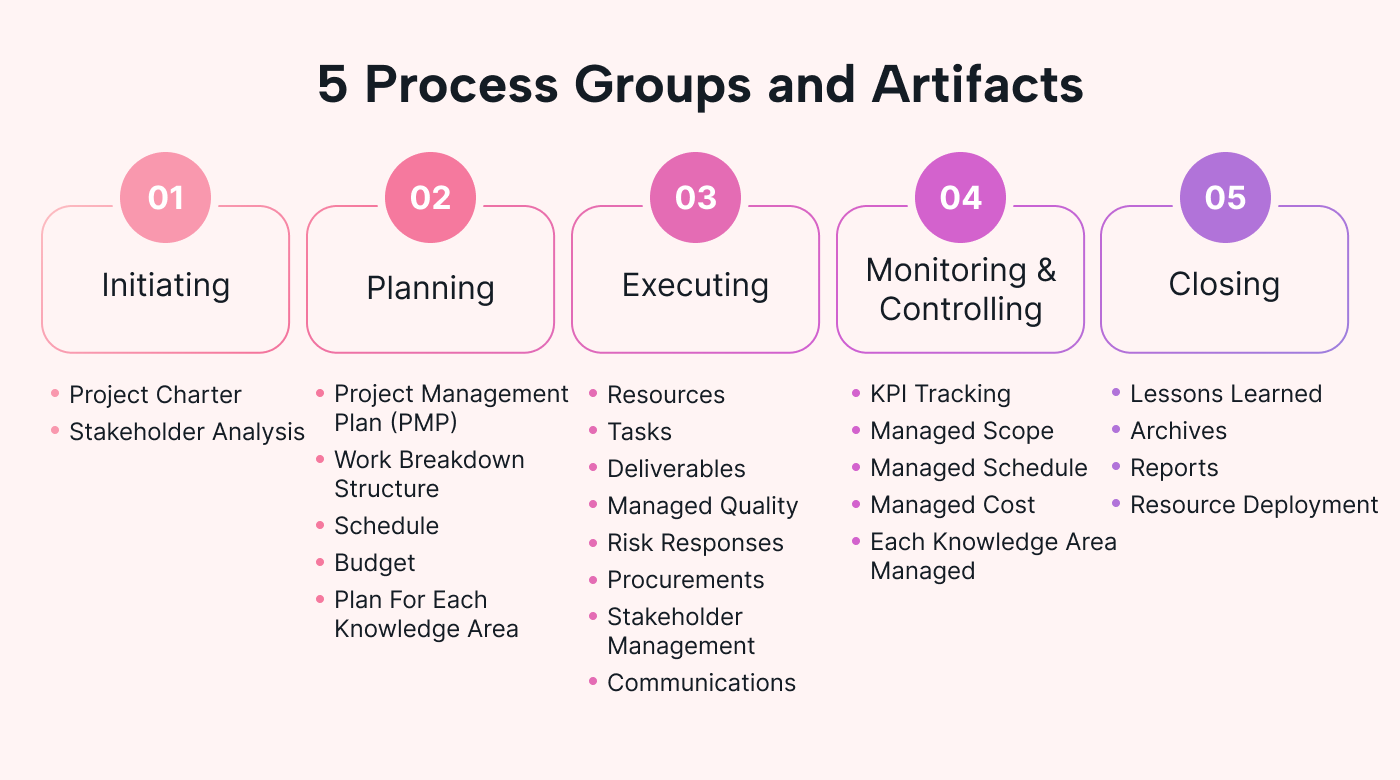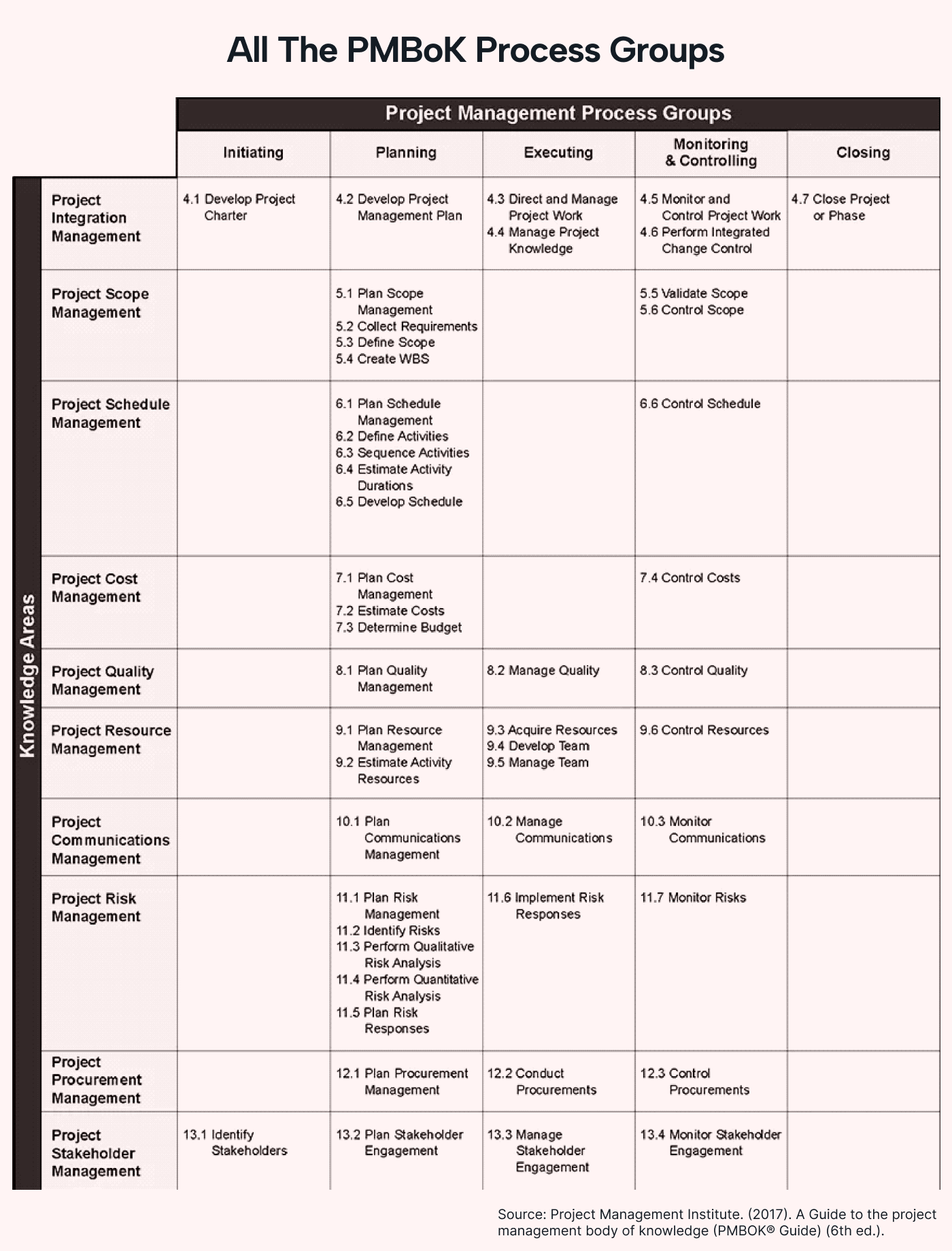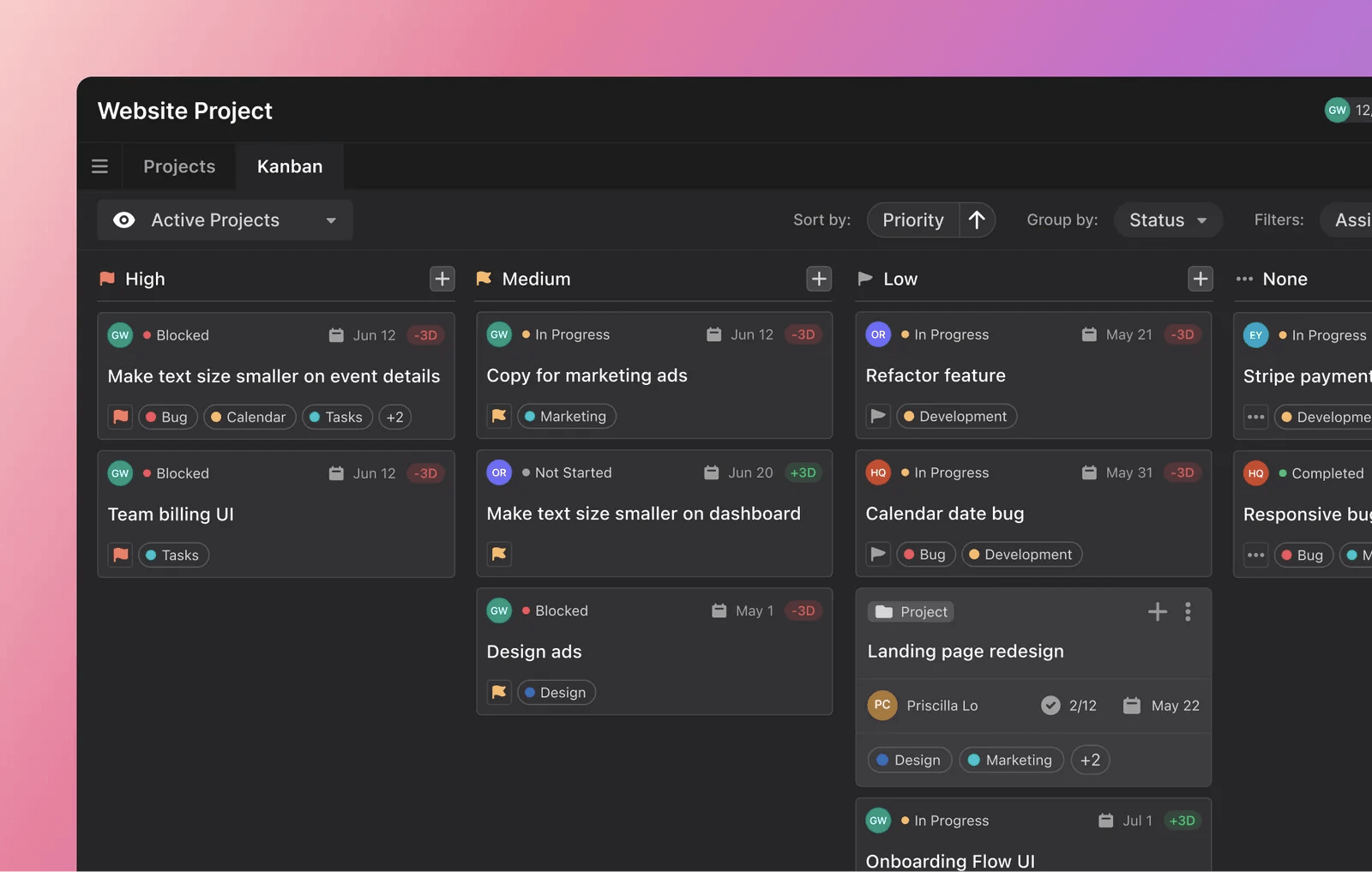Have you ever felt like you’re navigating through a project management maze, trying to find your way to success but constantly encountering roadblocks? Are you frustrated by all the issues that keep creeping in?
Many professionals grapple with the intricacies of project management, especially those who haven’t studied it formally. These process groups aren’t just fancy concepts—they’re the guiding light through the project management wilderness.
Together, we’ll uncover how they can help you overcome the hurdles that might be holding you back in your projects.
What are project management process groups?
Generally speaking, projects require five phases — initiating, planning, executing, monitoring and controlling, and closing. In each of the five phases, processes are performed from one or more knowledge areas.
All the processes carried out within a specific “phase” are called a “process group.” These are also called the PMBOK (Project Management Body of Knowledge) process groups.
Each process is part of a specific knowledge area. Each knowledge area takes time to learn and apply correctly, but once mastered, it will help lead to success. Executing the process group for each phase gets the project across the line.
While widely used, this approach can often appear complex and daunting, especially to managers and team members new to formal project management.
But what exactly is the significance of these processes, and how do they assist with projects? The answer is that these processes give you a structured approach to plan, execute, and manage a project successfully.
Let’s say you want to bake a cake. You don’t just whip out flour and eggs and start whisking—you need a recipe that guides you through the process step by step. In the same way, project management relies on these process groups to offer a structured approach for effectively handling a project.
A brief history of the PMBOK process groups
The Project Management Institute (PMI) is the creative force behind the PMBOK. They wanted to create a framework that supplies guidelines, best practices, standard principles, and a common language for managing projects.
In 1996, this vision was consolidated into a book commonly known as the PMBOK Guide. This book quickly became a cornerstone of project management and is even part of formal education in the field.
Fast forward to 2017, and the PMBOK Guide was by then in its sixth edition with 49 distinct processes. Each edition has been a step forward in refining and expanding the knowledge areas and processes.
The advantages of understanding the PMBOK process groups
The PMBOK process groups aren’t a one-size-fits-all solution—instead, they’re a template you can adapt and apply to all kinds of projects. They help ensure that resources are used effectively, timelines are met, and goals are achieved throughout an entire project.
Experienced project managers understand how the five process groups and ten knowledge areas interact and flow together. For example, they understand that the scope statement feeds the WBS and that a project charter feeds a project management plan while also drawing key info from the scope statement and WBS. They also understand that with this systematic approach, you’re less likely to miss crucial steps or elements along the way.
Knowledge about these processes also equips you with valuable project management skills.
What are the ten knowledge areas?
A process group is the set of processes from each relevant knowledge area that is executed during a phase. The ten knowledge areas are:
- Project integration management
- Project scope management
- Project schedule management
- Project cost management
- Project quality management
- Project resource management
- Project communications management
- Project risk management
- Project procurement management
- Project stakeholder management
The 5 process groups of project management
Below is an image that summarizes the basic outputs or artifacts of each of the 5 phases. Each artifact comes from or helps to govern a certain process.
 |
Before we dive into the details of the processes, let’s quickly review the main purpose of each process group and, therefore, the subsequent process. The five PMBOK process groups are:
- Initiating Process Group: kicks things off. It consists of processes required to launch a new project or a new major stage within an existing project.
- Planning Process Group: deals with defining the scope, schedule and budget for the project and creating the project management plan to map out how the project will be executed.
- Executing Process Group: relates to processes that help to perform project activities to produce the project deliverables and desired business outcomes of the project.
- Monitoring & Controlling Process Group: assess and adjust the performance of everything happening in the Executing Process Group.
- Closing Process Group: used to finalize and complete a project or major project phase.
Initiating
The initiating process group marks the official beginning of a project where the idea transforms into reality. In this phase, a project is formally approved and assigned to a project manager.
Within this group, two primary processes take place (these processes set the stage for what's to come later):
- Developing the project charter
- Identifying project stakeholders
The project charter houses key details, such as a high-level overview of the scope, deliverables, and objectives. It also includes the business case or business outcomes desired for the project.
Additionally, a project charter typically lists:
- A high-level timeline (or schedule)
- A high-level cost estimate
- Any known risks, issues, or dependencies
- Resources required
- Key stakeholders
Planning
The planning process group is where you create a full-on plan of attack. It consists of 24 processes, which makes it the most extensive of the five process groups.
 |
Here, the focus falls on capturing how you'll get from concept to deliverable in intricate detail. This includes defining the scope, schedule, budget, and how you'll manage key stakeholders.
Poor upfront planning is the leading cause of project failure, as reported by 31% of project managers. This statistic resonates with a simple truth—there's no excuse for not planning properly.
At the heart of the planning process group lies the project management plan (PMP). This document is like a grand novel's outline—it outlines the story, the characters, and the plot twists. The PMP contains a section for how each of the ten knowledge areas will be managed.
For larger projects, the PMP may have sub-plans that give further insight into critical areas, such as the project schedule or quality management. In contrast, for smaller projects, the processes might be more compact, in separate sections, or detailed in an appendix.
Another key detail about the PMP is that it's a “living document.” This means it isn't carved in stone but adapts and evolves as the project progresses and changes occur (as they often do).
To build a robust foundation for your projects, these are the key planning steps to follow:
- Start by breaking down larger deliverables into smaller, manageable pieces in a work breakdown structure (WBS). These smaller pieces (the lowest level of the WBS) become the tasks that are assigned to your resources.
- Gather all the necessary requirements, cost estimates, and time investments.
- Plan how you'll manage stakeholder relationships and facilitate cross-department communication.
- Break down the high-level plan into detailed activities and schedules, and define your milestones.
- Meticulously estimate how much time each activity will take.
You can fit all of this information neatly into the PMP.
Execution
The execution process group is where plans evolve into action. It’s also where most of the budget is spent, and the project’s tangible deliverables come to life.
Within the execution process group, there are ten essential project management processes. The focus in this process group primarily revolves around managing project activities and tasks.
The project manager wears multiple hats during this phase, with two key roles standing out:
- Directing and managing project work so that tasks are carried out as planned.
- Managing project knowledge means maintaining required documentation and updating plans.
It's often wise to bring in a project administrator or coordinator to handle some of the administrative tasks.
Other key responsibilities of the project manager include acquiring project resources, developing and managing the project team, and facilitating communications.
However, it's important to note that even the most well-crafted plans may need adjustments. This adaptability is where the next process group, monitoring and controlling, comes into play.
Monitoring and controlling
The monitoring and controlling group is the second-largest group, with 12 project processes. These processes are the guardians, helping you protect quality, scope, risk, cost, and time.
In most projects, unexpected circumstances will inevitably arise. However, they can be handled with the processes in the group. Here, the processes help to maintain clear oversight, identify any deviations from the plan, and guide corrective actions.
 |
One very useful tool in the executing and monitoring and controlling phase is project management software. Of course it also helps during the planning phase as you are defining your tasks. This software gives a digital vantage point so project managers can monitor and report on the project's progress. It can remove the need for manual scheduling and tracking and all the inefficiencies that go along with it.
Closing
The closing process group represents the grand finale of the project management journey. But before you can raise the victory flag, you need to tidy up your loose ends.
First, you need to:
- Check that all deliverables have been tested and validated.
- Compare the initial budget and timeline against what actually transpired during the project.
- Capture any lessons learned, problem areas, and key takeaways from the projects.
- Store any process that can be repeated, such as workflows, models, and finished products, for potential future projects.
Use Motion to apply your methodology
The next step toward success is choosing the methodology for your organization or venture. These give even more structure and guidance throughout the project as each houses more processes that can further help you get the results you want.
Out of all the top methodologies you can choose, you can use Motion to apply any of them. It has features that’ll help you track projects through the predictive approach (waterfall) and help you lock in tight timeframes.
It features a Kanban board (for an adaptive approach or Agile) with an AI assistant that can help you track the flow of work. It can also help you to quickly rearrange work if you need to with its simple drag-and-drop interface. The AI can generate schedules and allocate work for you based on dependencies, deadlines, and priorities.
Ready to use Motion to help you throughout your project lifecycle? Sign up for your 7-day free trial.





